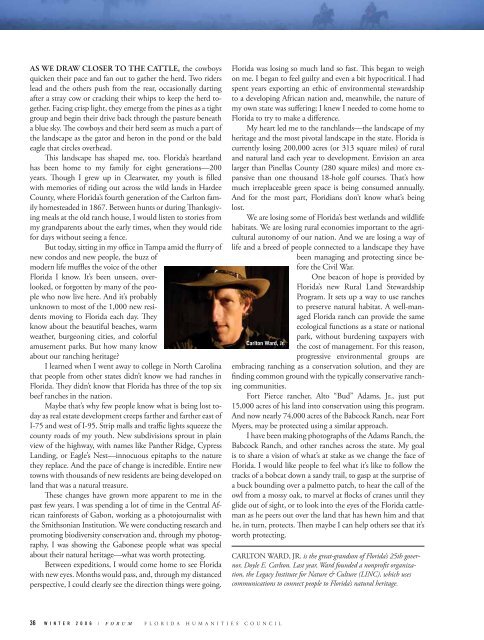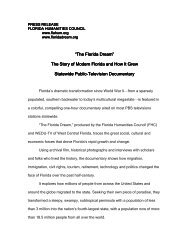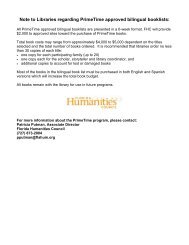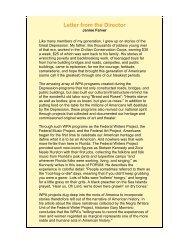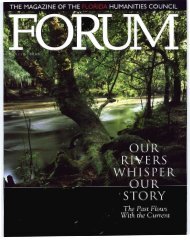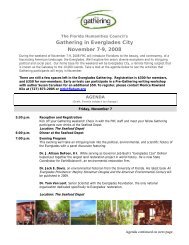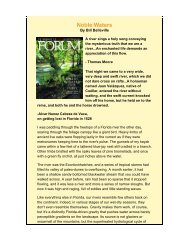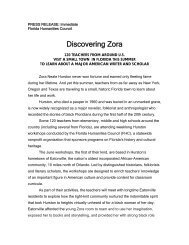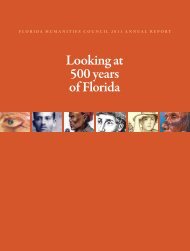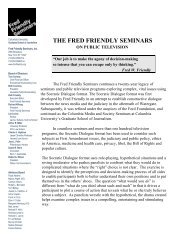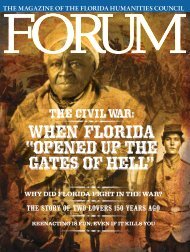THE MAGAZINE OF THE FLORIDA HUMANITIES COUNCIL
THE MAGAZINE OF THE FLORIDA HUMANITIES COUNCIL
THE MAGAZINE OF THE FLORIDA HUMANITIES COUNCIL
You also want an ePaper? Increase the reach of your titles
YUMPU automatically turns print PDFs into web optimized ePapers that Google loves.
aS We DRaW cloSeR to the cattle, the cowboys<br />
quicken their pace and fan out to gather the herd. Two riders<br />
lead and the others push from the rear, occasionally darting<br />
after a stray cow or cracking their whips to keep the herd together.<br />
Facing crisp light, they emerge from the pines as a tight<br />
group and begin their drive back through the pasture beneath<br />
a blue sky. The cowboys and their herd seem as much a part of<br />
the landscape as the gator and heron in the pond or the bald<br />
eagle that circles overhead.<br />
This landscape has shaped me, too. Florida’s heartland<br />
has been home to my family for eight generations—200<br />
years. Though I grew up in Clearwater, my youth is filled<br />
with memories of riding out across the wild lands in Hardee<br />
County, where Florida’s fourth generation of the Carlton family<br />
homesteaded in 1867. Between hunts or during Thanksgiving<br />
meals at the old ranch house, I would listen to stories from<br />
my grandparents about the early times, when they would ride<br />
for days without seeing a fence.<br />
But today, sitting in my office in Tampa amid the flurry of<br />
new condos and new people, the buzz of<br />
modern life muffles the voice of the other<br />
Florida I know. It’s been unseen, overlooked,<br />
or forgotten by many of the people<br />
who now live here. And it’s probably<br />
unknown to most of the 1,000 new residents<br />
moving to Florida each day. They<br />
know about the beautiful beaches, warm<br />
weather, burgeoning cities, and colorful<br />
amusement parks. But how many know<br />
about our ranching heritage?<br />
I learned when I went away to college in North Carolina<br />
that people from other states didn’t know we had ranches in<br />
Florida. They didn’t know that Florida has three of the top six<br />
beef ranches in the nation.<br />
Maybe that’s why few people know what is being lost today<br />
as real estate development creeps farther and farther east of<br />
I-75 and west of I-95. Strip malls and traffic lights squeeze the<br />
county roads of my youth. New subdivisions sprout in plain<br />
view of the highway, with names like Panther Ridge, Cypress<br />
Landing, or Eagle’s Nest—innocuous epitaphs to the nature<br />
they replace. And the pace of change is incredible. Entire new<br />
towns with thousands of new residents are being developed on<br />
land that was a natural treasure.<br />
These changes have grown more apparent to me in the<br />
past few years. I was spending a lot of time in the Central African<br />
rainforests of Gabon, working as a photojournalist with<br />
the Smithsonian Institution. We were conducting research and<br />
promoting biodiversity conservation and, through my photography,<br />
I was showing the Gabonese people what was special<br />
about their natural heritage—what was worth protecting.<br />
Between expeditions, I would come home to see Florida<br />
with new eyes. Months would pass, and, through my distanced<br />
perspective, I could clearly see the direction things were going.<br />
Florida was losing so much land so fast. This began to weigh<br />
on me. I began to feel guilty and even a bit hypocritical. I had<br />
spent years exporting an ethic of environmental stewardship<br />
to a developing African nation and, meanwhile, the nature of<br />
my own state was suffering; I knew I needed to come home to<br />
Florida to try to make a difference.<br />
My heart led me to the ranchlands—the landscape of my<br />
heritage and the most pivotal landscape in the state. Florida is<br />
currently losing 200,000 acres (or 313 square miles) of rural<br />
and natural land each year to development. Envision an area<br />
larger than Pinellas County (280 square miles) and more expansive<br />
than one thousand 18-hole golf courses. That’s how<br />
much irreplaceable green space is being consumed annually.<br />
And for the most part, Floridians don’t know what’s being<br />
lost.<br />
We are losing some of Florida’s best wetlands and wildlife<br />
habitats. We are losing rural economies important to the agricultural<br />
autonomy of our nation. And we are losing a way of<br />
life and a breed of people connected to a landscape they have<br />
been managing and protecting since before<br />
the Civil War.<br />
One beacon of hope is provided by<br />
Florida’s new Rural Land Stewardship<br />
Program. It sets up a way to use ranches<br />
to preserve natural habitat. A well-managed<br />
Florida ranch can provide the same<br />
ecological functions as a state or national<br />
Carlton Ward, Jr.<br />
36 W I N T E R 2 0 0 6 / F O R U M F L O R I D A H U M A N I T I E S C O U N C I L<br />
park, without burdening taxpayers with<br />
the cost of management. For this reason,<br />
progressive environmental groups are<br />
embracing ranching as a conservation solution, and they are<br />
finding common ground with the typically conservative ranching<br />
communities.<br />
Fort Pierce rancher, Alto “Bud” Adams, Jr., just put<br />
15,000 acres of his land into conservation using this program.<br />
And now nearly 74,000 acres of the Babcock Ranch, near Fort<br />
Myers, may be protected using a similar approach.<br />
I have been making photographs of the Adams Ranch, the<br />
Babcock Ranch, and other ranches across the state. My goal<br />
is to share a vision of what’s at stake as we change the face of<br />
Florida. I would like people to feel what it’s like to follow the<br />
tracks of a bobcat down a sandy trail, to gasp at the surprise of<br />
a buck bounding over a palmetto patch, to hear the call of the<br />
owl from a mossy oak, to marvel at flocks of cranes until they<br />
glide out of sight, or to look into the eyes of the Florida cattleman<br />
as he peers out over the land that has hewn him and that<br />
he, in turn, protects. Then maybe I can help others see that it’s<br />
worth protecting.<br />
CARLTON WARD, JR. is the great-grandson of Florida’s 25th governor,<br />
Doyle E. Carlton. Last year, Ward founded a nonprofit organization,<br />
the Legacy Institute for Nature & Culture (LINC), which uses<br />
communications to connect people to Florida’s natural heritage.


